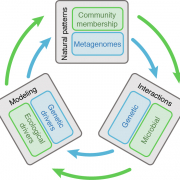PATHOCOM sampling underway
Under Aim 1 of our ERC-SyG project PATHOCOM, we are generating foundational data, by characterizing the intra- and interspecific diversity as well as abundance of pathobiota and commensal microbiota across multiple populations of A. thaliana in three regions in France, Germany and the US that provide geographic and genetic contrasts. We are doing this at a sufficient scale and with sufficient detail that it not only allows inferences about broad patterns, but also enables the detection of interactions between specific genomic variants in subsequent Aims.
We are collecting a structured sample of 3,600 wild plants (from 60 sites across six seasons), which we will genotype by whole-genome shotgun sequencing (WGS). We are planning to obtain conventional measures of microbiota diversity by bacterial 16S and eukaryotic ITS1 rDNA amplicon analyses, which we will also apply to soil samples and companion plants, both of which can be sources of infecting microbes. We will use pathogen enrichment sequencing, PEN-seq, to record in detail genetic variation in three common pathogens, Pseudomonas, Xanthomonas and Pantoea, as well as Sphingomonas. We will ascertain the presence and relative levels of different genes and genetic variants, and estimate diversity at the strain level for our focal taxa. A central question that we will address with these data is the extent of cooperation and competition within the A. thaliana pathobiota. In addition, we will learn how abiotic variables, pathogen richness and the composition of background microbiota and surrounding plants affect the success and genetic makeup of our focal microbes, at the level of individual plants, sites and seasons.
Here you see the team sampling in the Southwest of France.




